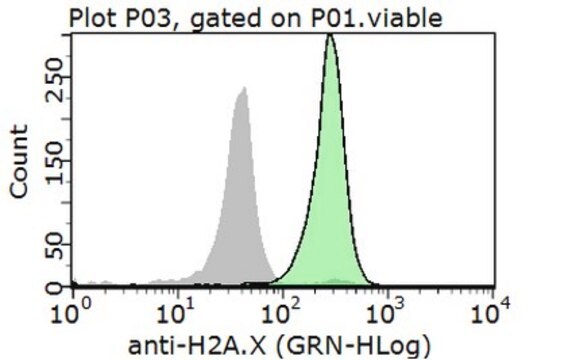07-164-AF647
Anti-phospho H2A.X (Ser139) Antibody, Alexa Fluor™ 647 Conjugate
from rabbit, ALEXA FLUOR™ 647
Sinônimo(s):
Histone H2A.X, Histone H2A.X, H2a/x
About This Item
Produtos recomendados
fonte biológica
rabbit
Nível de qualidade
conjugado
ALEXA FLUOR™ 647
forma do anticorpo
purified antibody
tipo de produto de anticorpo
primary antibodies
clone
polyclonal
reatividade de espécies
human
reatividade da espécie (prevista por homologia)
vertebrates (based on 100% sequence homology)
técnica(s)
immunocytochemistry: suitable
Isotipo
IgG
nº de adesão NCBI
nº de adesão UniProt
Condições de expedição
wet ice
modificação pós-traducional do alvo
phosphorylation (pSer139)
Informações sobre genes
human ... ATP10D(57205) , H2AX(3014)
Descrição geral
Especificidade
Imunogênio
Aplicação
Epigenetics & Nuclear Function
Epigenetics & Nuclear Function
Histones
Chromatin Biology
Qualidade
A 1:100 dilution of this antibody detected phospho Histone H2A.X (Ser139) in HeLa cells.
Alexa Fluor™ is a registered trademark of Life Technologies.
Descrição-alvo
forma física
Armazenamento e estabilidade
Outras notas
Informações legais
Exoneração de responsabilidade
Not finding the right product?
Try our Ferramenta de seleção de produtos.
Código de classe de armazenamento
12 - Non Combustible Liquids
Classe de risco de água (WGK)
WGK 2
Ponto de fulgor (°F)
Not applicable
Ponto de fulgor (°C)
Not applicable
Certificados de análise (COA)
Busque Certificados de análise (COA) digitando o Número do Lote do produto. Os números de lote e remessa podem ser encontrados no rótulo de um produto após a palavra “Lot” ou “Batch”.
Já possui este produto?
Encontre a documentação dos produtos que você adquiriu recentemente na biblioteca de documentos.
Nossa equipe de cientistas tem experiência em todas as áreas de pesquisa, incluindo Life Sciences, ciência de materiais, síntese química, cromatografia, química analítica e muitas outras.
Entre em contato com a assistência técnica






![Western Blocking Reagent, Solution solution, sufficient for 10 blots (11921673001 [100 cm2]), sufficient for 60 blots (11921681001 [100 cm2])](/deepweb/assets/sigmaaldrich/product/images/352/091/ef743cea-ccd8-44f1-8f3b-dec5a1e4f5d1/640/ef743cea-ccd8-44f1-8f3b-dec5a1e4f5d1.jpg)

